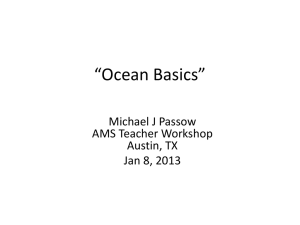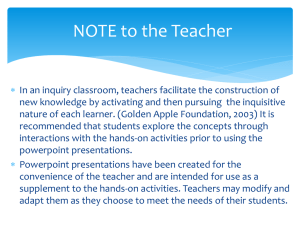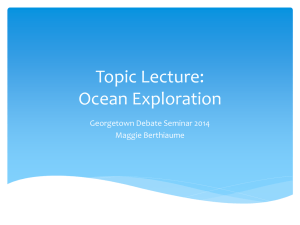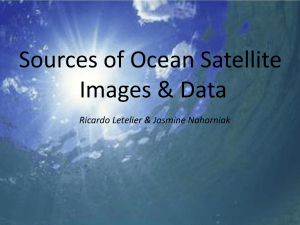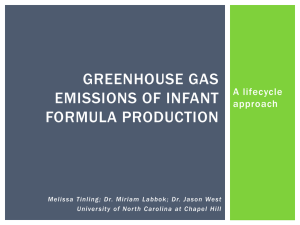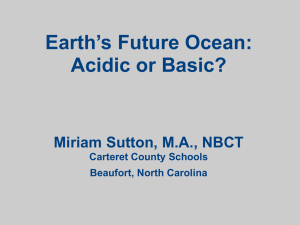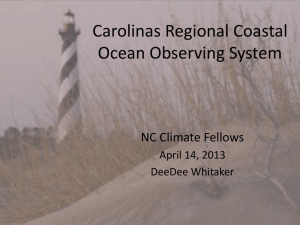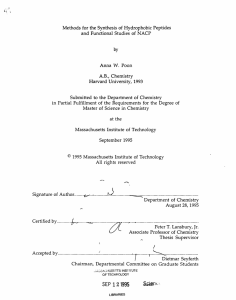presentation - North American Carbon Program
advertisement
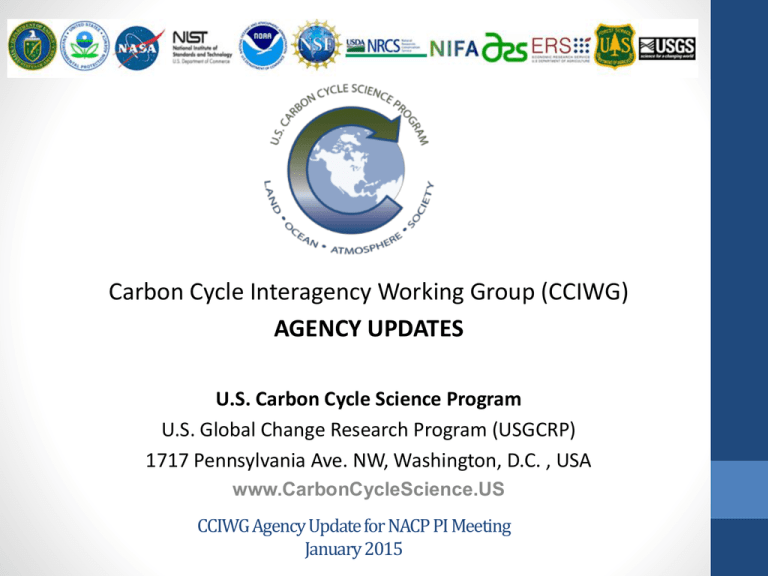
Carbon Cycle Interagency Working Group (CCIWG) AGENCY UPDATES U.S. Carbon Cycle Science Program U.S. Global Change Research Program (USGCRP) 1717 Pennsylvania Ave. NW, Washington, D.C. , USA www.CarbonCycleScience.US CCIWG Agency Update for NACP PI Meeting January 2015 www.CarbonCycleScience.us An Interagency Partnership: Providing a coordinated & focused scientific strategy for conducting federal carbon cycle research What does the CCIWG do? • Promotes interagency cooperation and coordination; • Helps secure funding, prepare individual & joint agency initiatives & solicitations; and • Involves the scientific community in providing the needed science to understand the carbon cycle. Major CCIWG Programs & Activities: (in addition to funding programs by individual agencies) See Poster for details. www.CarbonCycleScience.us Other updates • GCP SSC co-chair Rob Jackson, new member Galen McKinley • RECCAP NA Paper – King et. al. published • Workshop/report/special activities sponsorship request Guidelines now available online on carboncyclescience.us. • COP-19 Side event with USDA – ‘US and International collaboration in C Cycle Science’ • Plans for SOCCR-2 • CCIWG co-chair transition—Current Co-Chairs Nancy Cavallaro and Dan Stover • See CarbonCycleScience.us for more. CCIWG Member Agency UPDATES USDA Forest Service Carbon Cycle Research Program The New US Forest Carbon Accounting Framework (US FCAF Version 1.0) • The FCAF system will be comprised of a forest dynamics module and a land use dynamics module. This modeling framework includes opportunities for user-defined scenarios evaluating the impacts of land use change and disturbance rates on future carbon stocks and stock changes. • Developed over next 9 months for the 2016 NGHGI (released internally by October 2015) USDA Forest Service Carbon Cycle Research Program • Reducing Uncertainty and Increasing Consistency: Recent Technical Improvements to the 2015 United States Forest Carbon Inventory • • • • • Annual progress on official US NGHGI & continue in situ observations Refine stock estimation by pool Extend inventory to all managed lands Improve LUC, baselines, and attribution Benefits current and future commitments but also climate change monitoring • Carbon Cycle Science in forest, rangeland and urban ecosystems research: • Pools and fluxes of carbon in ecosystems • Impact of management on carbon • Carbon GHG emissions due to fire • Carbon Monitoring • Research to better understand carbon pools • Research to develop better assessment methods • Develop tools for managers to assess carbon in forests, rangelands & urban ecosystems NIFA—programs and developments • AFRI RFAs: delayed pending language to comply with latest Farm Bill but– Climate, Food Security, BENRE RFAs (3) expected soon. – Working on potential future RFAs: Bioenergy, Water-FoodEnergy, Carbon Cycle—single and multi-agency • Funding for research combined with outreach/extension, decision support, education • Capacity funding for AES and Forestry schools—increasing projects on carbon, GHG, climate • Recent workshops: Soil Organic Matter—International conference • Upcoming workshops: Climate Smart Agriculture-Feb. 2-3, 2015; Soil CN MIP workshop-March 2-4, 2015 • Climate PD meeting April 7-9, 2015 Other USDA • ARS: • LTARs—10 sites • Gracenet—Identify and further develop agricultural practices that will sequester carbon and sustatinably reduce GHG, Standard protocols for measurements • USDA-NRCS Ongoing Projects • Comet-Farm: Next generation of COMET2.0. Whole farm GHG analysis including crops, livestock, agroforestry and fuel use • SNOTEL (snow telemetry) and SCAN (Soil Climate Analysis Network: Monitoring for water supply forecasts in west and soil moisture/soil temperature trend data in 50 US states and Antarctic • NRI data collection and satellite imagery of Alaskan sites • OCE - USDA Regional Hubs for Risk Adaptation and Mitigation to Climate Change—7 regional centers, Forest Service and ARS collaborating with Universities and other centers U.S. Department of Energy Office of Science Office of Biological & Environmental Research Terrestrial Ecosystem Sciences Daniel Stover, Ph.D. and Michael Kuperberg, Ph.D. Program Managers Daniel.Stover@science.doe.gov Michael.Kuperberg@science.doe.gov http://tes.science.energy.gov/ Office of Science Office of Biological and Environmental Research Terrestrial Ecosystem Science TES Approach- model-inspired fundamental research: •Observations (e.g., AmeriFlux network) •Large-scale, long-term field studies and manipulations (e.g., SPRUCE, NGEE, prior FACE studies) •Synthesis (e.g., NACP and FACE) •Research questions in the context of needs, process and structure of Earth system models Funding to both universities and DOE National Labs--Annual university Funding Opportunity Announcement (FOA) released in the summer/fall for funding in next fiscal year Coupled Model-Experimental Linkages (MODEX) • “Predictive understanding” is code for MODEX. • Our goal is to coordinate process and modeling science to maximize scientific outcomes. • This is not a one-way street, it is an iterative dialog (a “new” way to do business). • We recognize the importance of and role for “discovery science”. Major DOE Initiatives in Carbon Cycle Science Next Generation Ecosystem Experiments (NGEE) – NGEE focuses on systems that are: • Globally important; • Climatically sensitive; • Insufficiently understood or represented in coupled models – Ongoing efforts in Arctic (ORNL led, year 3) and tropical (LBNL led, year 1) ecosystems AmeriFlux • DOE BER supports AmeriFlux network infrastructure and provides ongoing support to the network and for maintenance of long-term data records SPRUCE • Ecosystem experiment to test responses of high-carbon, high-latitude peat ecosystems (northern Minnesota) to elevated [CO2] and warming (collaboration with USFS) NASA Update • Carbon Cycle Science selection in 2014 – USDA, DOE, NOAA, and NASA - 235 compliant Step-2 proposals with 41 selected for funding - approximately $37 million over three years • OB&B program has the EXport Processes in the Ocean from Remote Sensing (EXPORTS) – draft science plan under review, plus two others – Scoping for Interdisciplinary Coordinated Experiment of the Southern Ocean Carbon Cycle (ICESOCC) and Arctic COastal Land Ocean InteRactions Scoping Study (Arctic-COLORS) • Pre-Aerosol, Cloud, ocean Ecosystem (PACE) mission is moving forward (some focus on carbon in the atmosphere, ocean, and at the land/ocean interface) • Diane Wickland has retired, Eric Kaschiske and Kathy Hibbard now lead the TE program • ROSES Task A.4 – Terrestrial Ecology soliciting for the Arctic-Boreal Vulnerability Experiment (ABoVE) Field Campaign. Will phase up to $7 to 8 million per year by 2017/18 • NACP Office: Coordinator, meeting planning, web presence, database of projects, personnel, publications - about 2.2 FTE spread across 12 people • - NASA has sponsored 220 investigations since NACP's inception • - Carbon Monitoring System: 53 projects from CMS are part of NACP • - Coastal Carbon Synthesis: underway with final report 2015 • ROSES LCLUC 2012 and 2013 highlighted three projects in support of NACP (G. Gutman) • OCO-2 launched July 2, 2014, the spacecraft and instrument are working quite well. L1B data are now available at the GSFC DAAC. • The 3rd selection of CMS investigations occurred this past year, concentrating on regional and state biomass and flux activities. The next solicitation is expected in ROSES 2016. NOAA Greenhouse Gas Reference Network • In 2015 NOAA is working to restore several of the sites lost owing to cutbacks since 2006. • Re-establish East Pacific Cruise Track and several other surface flask sites. • Re-establish and increase frequency of flights at aircraft sites. • Upgrade observing systems at tall towers. • Shore up infrastructure at Atmospheric Baseline Observatories. • Increase frequency of 14CO2 measurements at some sites. * Yellow symbols represent sites that were discontinued in the past, generally owing to funding cuts. Some are being restored. Quality Control Checks on Earth Networks Data • Earth Networks has started measurements of CO2 and CH4 at 28 cell phone towers in the US. • Instruments are from Picarro. • Inlets and package design are from Scripps Institution of Oceanography. • Calibration gases are from NOAA (World Calibration Scales). • Data processing is by EN. • Analysis is by NOAA. • NOAA is deploying flask packages at four EN sites. • NOAA is comparing data from selected EN towers with CarbonTracker estimates. • Bias so far seems minimal, if at all. • Probability of added value of EN data to CarbonTracker and other analyses is good. FY13-FY15 AC4 Research Portfolio and NOAA Partners Nitrogen Cycle Urban and Oil & Gas Emissions N2O, NH3, HNO3, Aerosols CH4, CO ESRL/CSD Field Campaigns GFDL Modeling N2O, NH3, HNO3, CO, Aerosols NH3, O3, CO, Aerosols CarbonTracker CH4, CO2 ESRL/GMD Monitoring CO2, CH4 FY16 Priority BIOMASS BURNING Science Questions: • What are the emissions of gases, aerosols, aerosol precursors and greenhouse gases from North American fires? • What is the chemical transformation of those emissions? • What is the local air quality and visibility impact of North American fires? • What are the regional and long-term impacts of North American fires? • What are the climate-relevant properties of BB aerosols? AC4 current and future activities: • Solicitation of Interest: polling the atmospheric chemistry and carbon communities about their interest in biomass burning research • Future plans: collaboration with ESRL scientists; FY16 and FY17 calls for proposals Timeline NOAA’s Ocean Acidification Program (OAP) Updates -Marine Sensor Transition grant awarded to Jan Newton at UW jointly funded by IOOS (integrated ocean observing system) and OAP -OAP FFO entitled “OA and nutrient loading to coastal marine ecosystems” proposals have been received and are under review -OAP received a $2.5m increase in funding from Congress for FY15. Roughly 50% of this increase will go to competitive grants. -Please check our website www.oceanacidification.noaa.gov for more updates on currently funded projects, funding opportunities and outreach and education resources. NOAA Climate Program Office Climate Observation Division Ocean Carbon Observations Tropical Pacific Observing System 2020 Goals • To monitor, observe, define the state of ENSO, and improve scientific understanding; • To support observation and prediction systems for ocean and weather and climate services, including underpinning research; • Advance/refine knowledge of tropical Pacific predictability (physical and biogeochemical) and its climate impacts; and • To relate ocean/climate variability and change to marine biogeochemistry and biology and carbon budgets, food security and biodiversity NSF Updates for NACP • Ecosystem Studies Program in DEB is searching for 1-2 new permanent program officers (search closes Feb. 9), in addition to 1-2 rotators to start next Fall – contact Henry Gholz • Critical time: big data, more observation-based science (NEON and OOI moving into operations), maturing microbial and other technologies, carbon cycle-related science more centrally and societally important. Need is for collaborative, connected mid-career POs, for leading development of “NG ecosystem science.” • MacroSystems Biology, with a focus on scaling knowledge, has been put on a hiatus for a year to sort out its relationship with NEON and core programs at NSF. • Some SEES (Sustainability) solicitations are still active, so monitor websites and solicitations. • RCN (Research Coordination Network) proposals are encouraged, along with workshops. In BIO, watch for more NEON-related opportunities in the future. USGS update to NACP • USGS is completing two regional carbon balance assessments: Alaska and Hawaii. Each of the assessments will produce a USGS report and several synthesis journal papers in 2015 or 16. A synthesis workshop is planned for Alaska. • USGS continues to implement a priority of providing carbon monitoring support to land management agencies in the Department of the Interior. The goal is to link science to land management and restoration practices and policies. • USGS is collaborating with NASA’s ABoVE program to support research, data collection, and application in boreal and arctic ecosystems • USGS is leading research and providing data for carbon/CO2 fluxes in the aquatic environment throughout the nation NIST Greenhouse Gas and Climate Science Measurements Program Objectives: • Develop advanced measurement tools and standards to improve accuracy capabilities of: • Greenhouse gas emissions inventory data • Improving emissions measurement & reporting accuracy • Independent methodologies to diagnose and verify emissions data both nationally and internationally • Applications focused on cities and metropolitan areas U.S Emissions in 2012 - 6,526M Metric Tons CO2 equivalent • Remote observing capabilities – satellite and surface-based • Extend measurement science and tools underpinning advances in understanding and description of Earth’s climate and its change drivers NIST Greenhouse Gas and Climate Science Measurements Program Components • Stationary/Point Source Metrology – Increase accuracy of Continuous Emission Monitoring technology • Flow Measurement Test Beds – stack simulators • Geospatially Distributed GHG Source Metrology – Measurement Tools and Test Beds Characterizing Emission in Urban GHG Concentration Domes • Compare methods to determine GHG Emission Inventory Accuracy – Bottom-up vs. Top-Down • Urban GHG dome test beds Indianapolis Flux Experiment (INFLUX) Los Angeles Megacity Carbon Project Northeast Corridor Project • Propose an International GHG Metrology Framework Supporting Inventory Diagnosis and MRV Based on Megacities • Measurement Tools, Standards, and Reference Data • • • • GHG Concentration Standards Spectroscopic Reference Data Surface Air Temperature Assessment Atmospheric Flux Measurement Tools • Advancing Satellite Calibration Standards • • • • Microwave Observing Instruments Optical Radiometric Methods TOA and Surface Solar Irradiance Surface Albedo Standards • Measurement Science of Carbonaceous Aerosols • Advance Optical Property Measurements • Development of Reference Materials This afternoon at 4:00 THANK YOU! CONTACT: gshrestha@usgcrp.gov U.S. Carbon Cycle Science Program Office U.S. Global Change Research Program (USGCRP) National Coordination Office (NCO) 1717 Pennsylvania Avenue NW, Suite 250, Washington, D.C. 20006, U.S.A. FOLLOW US @USCarbonProgram CarbonCycleScience.US
